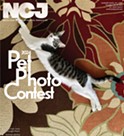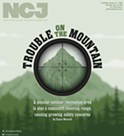[
{
"name": "Top Stories Video Pair",
"insertPoint": "7",
"component": "17087298",
"parentWrapperClass": "fdn-ads-inline-content-block",
"requiredCountToDisplay": "1"
}
]
Only a handful of painted scrap panels leaned against the steps and shrubs outside Curtis Otto's orange stucco house on Eureka's E Street. The crowd of oil paintings that cluttered the artist's front yard was gone, but stepping through the unlocked front door you had to work your way around and over the canvases stacked three-deep in the entry and dark hallway.
In the back of the house, more paintings packed the walls and ledges in a chaotic salon style that verged on hoarding. But weeks before his Nov. 7 death, lying in the purple sheets of a hospital bed, the 92-year-old Otto's bright blue eyes darted across a bare ceiling. Following a couple of falls in September, his health had declined. His precise illness was undetermined and he wasn't interested in undergoing tests or leaving his house. Home care workers tended to him in shifts, and hospice staff made regular house calls, as there was no phone. And a steady stream of visitors, mostly artists, came by daily, some bringing food or buying paintings, to visit with the iconic local painter.
Asked how he felt about influencing so many artists, he barked out, "Yeah, why is that?"
His talent and his dogged pursuit of ways to push the medium of painting are part of it. Nearly everyone you talk to says the same thing — his example of discipline and his unwavering attention to painting inspired artists to work harder, to go further. He might train his laser focus on a problem in your painting and talk with you in earnest. He might paint over it himself to "fix" it. His attention was on painting, on the canvas before him, not the money it might bring him, not the damage the elements were doing to finished pieces in the muddy yard or the toll his mission took on his relationships. But as he said in a 1996 artist's statement, "When you're compelled to paint, everything else becomes subordinate."
The same single-mindedness that made him so admired and so prolific might also be the reason he's never achieved much recognition outside the borders of his two homes, Humboldt County and Grants Pass, Oregon. His legacy, like the whereabouts of so many of his paintings — sold, traded, lost and scattered — is hard to lay hands on, but it is real and it is the accumulated work of a lifetime.
Otto was born in Eureka in 1923, the son of a pharmacist. It was during his college years at the University of New Mexico, when he was studying to follow in his father's footsteps that he took elective art classes and caught the bug. He practiced as a pharmacist on and off for a couple of decades, but left to paint full time in the 1970s. In that time, he'd married and divorced Roberta Schisley, with whom he had two children. He studied at the Arts Student League in New York for a few months in the 1960s, but beyond that he's remained a fixture in two small worlds.
"You walk into his studio in Grants Pass and it was like, where does he paint?" recalled Chris Pondelick, former executive director of the Grants Pass Museum of Art. Over the phone from Oregon, she said the workspace was stacked with so many paintings that Otto sometimes had to throw down a canvas and work on the floor. The studio, like his home in Eureka, was often unlocked, with artists coming and going, and paintings left unattended out on the street to dry. Pondelick met Otto in 1979, when he was helping get the newly formed museum on its feet, putting in sheetrock, hanging art and serving on the exhibition committee. He and his cohort, "the passionate seven," would pool their money for live models and paint in houses, in fields, anywhere. "You'd always see him painting or you'd see him hauling his stuff down the street." He might be dragging art supplies or a painting he wanted to talk about with someone.
"He painted every day," marveled Pondelick. "He would concentrate on a series and really work that every day until he was happy with it and then move onto another series." Otto's series are legion — ships, money, bridges, industrial landscapes, marijuana, nudes, women's nude posteriors, to name a few. That work ethic, as much as his skill as a painter and strong aesthetic style, were magnetic.
When painter Jim McVicker moved to Humboldt County in 1978, he met Otto in a life drawing group. McVicker casually invited him to visit his studio sometime. "The next day, early in the morning," he said, "there was a bang, bang, bang! And it was Otto." McVicker lived with Otto for about a year in 1984, acting as caretaker when Otto was away. "I loved living with Otto," he said, "because he was 120 percent art. He was always painting." Their styles were different, but Otto's intensity inspired. It wasn't just that Otto was working every day, but that he was constantly thinking about the work.
Otto appreciated that same intensity in others. Tommy Drake, who teaches studio art at Rogue Community College, said engagement was always paramount for Otto. "What was his phrase?" she said over the phone. "'That person's really involved.' ... If he thought they were really involved, then they were OK no matter what the work looked like."
Otto's criteria kept him open to relative outsiders, like his friend Peace, a Grants Pass street painter. A slender man dressed in black with a trim, white beard and a black head scarf like a pirate's, Peace speaks in soft tones and is given to reciting poems. He stayed in the Eureka house at times and would drive Otto between Eureka and Grants Pass. "He was one of those really involved people," Drake said. She remembers the two men painting on the sidewalks of Grants Pass. Otto's son, Jason, recalled going to a show in Eureka with his father, who began talking in earnest with a "transient type reciting poetry." Jason said Curtis didn't care about outward appearances or whether someone was homeless. "He just kind of met them on the artistic level."
Curtis Otto was just as ready to grapple with the "problem" in someone else's piece as his own. "He was an incredible supporter of your art," said Pondelick. "He was so encouraging. And if he didn't think you were doing your art enough because you were off on some other thing, he'd say, 'Why aren't you doing your art?'"
She sighed, remembering how effective the guilt could be in getting her back in the studio. McVicker posited it's that kind of attention that made Otto such a "positive force" in the local art community. "He has a genuine love for looking at what other people are doing and making," he said, adding that, even ill, Otto offered a sharp critical eye. "He still has it. ... He's lying there in bed and talking about art."
Otto had always been wiry, small of build with hooded blue eyes under wild brows like snatches of straw. But he'd lost weight since spring, rendering his silhouette a spare line drawing, the sharp peaks of his knees and the suggestion of a form beneath the sheet tucked up to his chin.
He said he was still trying to figure out what gives a painting "juice," what would "turn you on" or make it "talk." He said, "It's always a surprise to me." He didn't know how he'd accumulated his admirers, either. "Why do they think my painting turns 'em on?"
Otto's recent work features stenciled text, sometimes single words in block letters. "It's a different visual experience," he said. Instead of leaving it to the viewer to contemplate, "you're completing the statement with the word."
Taped to a wall in Otto's home is a Jim McVicker landscape from an old, flyspotted calendar — a sweep of pasture, scattered cows and pines — over which Otto had stenciled "LOLETA" in red. He said the image didn't work until he added it.
McVicker has seen the Loleta stencil and likes it. He understands Otto's project of juxtaposing real images and abstract ideas, of keeping a painting from being "just another landscape." In fact, he said with a laugh, Otto also did some after-market work on a street scene McVicker traded him, attaching another piece and crossing the painting with a big stripe. Otto added to one of Jack Sewell's sculptures, too. Sewell was surprised to stop by the house and see his piece with a stenciled 3 on it. "I couldn't begin to tell you why the number 3," he says. "It's his now!"
When Otto's throat got dry, Marcee Siemens stepped over her white Staffordshire terrier Spanky, picked up a cup of water and held the straw to Otto's lips. Siemens is in her early 60s with large hazel eyes and a spray of ash blonde dreads held back in a fabric band. A textile artist, she met Otto in 1988 when she had a show at the Grants Pass Art Museum and he was on the exhibition committee. They had quietly been together on and off since the late 1990s.
"Back then I didn't care for his work. It was too stiff," she said, folding her arms over her padded vest. As far apart as their aesthetics were, she found his dedication inspiring and it pushed her. They shared a studio and became involved in 1996, after her divorce, when Otto was living with his longtime companion Loretta Roberts in Grants Pass. The relationship wasn't public. "I had respect for the companion," Siemens said. "I knew Loretta." Otto nodded lightly from his bed as she spoke.
Siemens was staying in the Eureka house to help with Otto's care. It wasn't unusual for her to come down and stay with him there in the old days, but it wasn't always a honeymoon. "We were so volatile, sometimes I'd leave after a day," she said. Sometimes they fought about art. She claims he stole her ideas, whipping up basketball player paintings after seeing similar images in the woven pieces that took her far longer to produce. At one point she banned him from her studio. Later, she simply covered her work before his visits.
Asked if he had anything to say in his defense, Curtis looked back to the ceiling and shook his head. "No."
Siemens laughed. "We've never broken up. We've broken up at least a thousand times, right Curtis?"
"Yeah," he replied.
Jack Sewell's business card is taped to Otto's front door. He showed Otto's paintings at the former Sewell Gallery in Old Town and started handling some sales to help out. "He's one of the most devoted painters I've ever met in my life, if not the most," Sewell said. In their conversations, there was no gallery small talk, no politics, no family. "It took a long time to just learn he had a family." Sewell once ran into Curtis with his daughter Adrienne Otto, a veterinarian who lives in Humboldt County. "Otherwise," Sewell said, "I wouldn't have even known he had a daughter." Likewise, Sewell only learned Otto had a son when Jason showed up at a show. It's a comment echoed by a number of other artists, friends and gallery owners in Humboldt and Grants Pass.
Jason Otto lives in Seattle where he works for Boeing as a software designer and paints, among other things, intensely colored acrylics of airplanes being assembled. They don't resemble Curtis Otto paintings, though they are expressionistic. Still, there is something of a shared aesthetic, an interest in architecture and the raw edges of things. He doesn't paint nearly as much as his father and shies away from any comparison. But, he said, "I kind of like to think that I picked up design from him."
"Art defines his life," Jason explained over the phone. "He's kind of like Einstein or somebody who's 100 percent devoted to something — even when they have downtime they're still thinking about it." He's not surprised there are few wild tales circulating about his father. "Things like drugs or craziness would get in the way."
As a child, Jason remembers watching his father paint and even taking a painting to school once after a principal had asked to see one. The principal told Jason to ask his father why he'd painted the sky orange. Curtis' reply: "Because it looked good." Jason agreed.
"I've always gotten feedback from him," said Jason. "It's not the kind of thing that's you should do this." Often he talked about how to make pieces interesting and creative, something more. "Once, he said I was 'a damn good artist' and that was a great compliment."
At a gallery reception last spring, Curtis Otto scoffed at worry over the paintings out on his lawn for anyone to steal. He waved a knotted hand. "I can't sell anything."
Otto insisted he never painted with selling in mind. "I've never been turned on to paint to sell," he said. And while he railed against the "safety-first academia" that he claimed never recognized his work, and the prudish galleries he says shunned his nudes, he maintained that he didn't get wrapped up in money or fame.
Maybe not, but McVicker thinks recognition did matter. He pointed out that Otto's extremely modest lifestyle allowed him to underprice his paintings, do without an agent and get by on small sales. He said Otto once told him that he wasn't going to Los Angeles or San Francisco; those galleries were going to have to come to him. "But he's always wanted to show his work."
Pondelick remembers Otto telling her a story about visiting an out-of-town gallery showing his work. He told her that he found it shuttered, his paintings gone. She thinks the experience turned him off to marketing beyond his usual borders.
An artist himself, Sewell said he wouldn't put Otto "up in the ranks of genius with Renoir and Pissaro, but he's almost in the van Gogh region with his passion and his fire. Sewell said he's grown to understand what Otto was up to, how he absorbed what impressionistic and representational artists did and "just push[ed] it further" with geometric elements, odd framing and even crudely fastened composites. Despite that talent and the strength of his work, Sewell thinks Otto didn't break out of Grants Pass and Eureka because "he's never had the wherewithal to advertise himself. ... He's a successful painter, that's for sure, but as for a career, ... somehow he never got picked up on." Sewell said Otto seemed to be waiting for some agent to come out of nowhere and discover him.
In his final weeks, Otto was talking to visitors about the "Viennese collection," a handful of his paintings in Austria. Painter Linda Mitchell, a neighbor and longtime friend of Otto's, said he was excited to have "gone international" and the possibilities it could open up. It's unclear, however, how much Otto understood about the details. In 1997, a woman (who declined to have her name included here) bought five Otto paintings from the now defunct Hobart art gallery in Ferndale as a wedding gift for her daughter, an art historian. Her daughter moved with them to and from South Africa and to Vienna, where she now enjoys them in her home. When she recently bought three more paintings, the woman told Otto where her daughter's pieces had ended up.
"They bought them outright," Otto said, remarking that galleries usually take work on consignment. He spoke about those paintings and the three other pieces as though they were going to show in a gallery.
The Grants Pass Museum of Art will exhibit a small retrospective of some 20 paintings from Curtis Otto's Grants Pass studio, chosen by his son Jason, from Feb. 17 to March 25. It's dizzying to think of choosing 20 from a 60-year span, most of which saw Curtis Otto paint daily. The prospect of sorting the haphazard mountain of paintings in his Eureka home is similarly daunting.
Jack Sewell chuckled recalling what a pain in the ass it was cleaning Otto's paintings for a show. He said they had to drag them out of piles in the house, soap and hose them down to remove the dust, soil, earwigs and spider webs, and dry them before they could hang in the gallery. "They're not precious to him ... He'd take paintings and just throw 'em in the back of a truck and not care whether they were sticking together or wet or — ugh."
And why would they be precious? Otto was a painter, after all, not an archivist or a promoter or a curator. A painter paints.
more from the author
-
SCOTUS on the Homeless, CPH Protest and Local Entertainment
- Apr 26, 2024
-
Look Up for Rooftop Sushi
- Apr 19, 2024
-
Resentencing, CASA Kids and Freaky Fish
- Apr 19, 2024
- More »
Latest in News
Readers also liked…
-
Through Mark Larson's Lens
A local photographer's favorite images of 2022 in Humboldt
- Jan 5, 2023
-
'To Celebrate Our Sovereignty'
Yurok Tribe to host gathering honoring 'ultimate river warrior' on the anniversary of the U.S. Supreme Court ruling that changed everything
- Jun 8, 2023



































